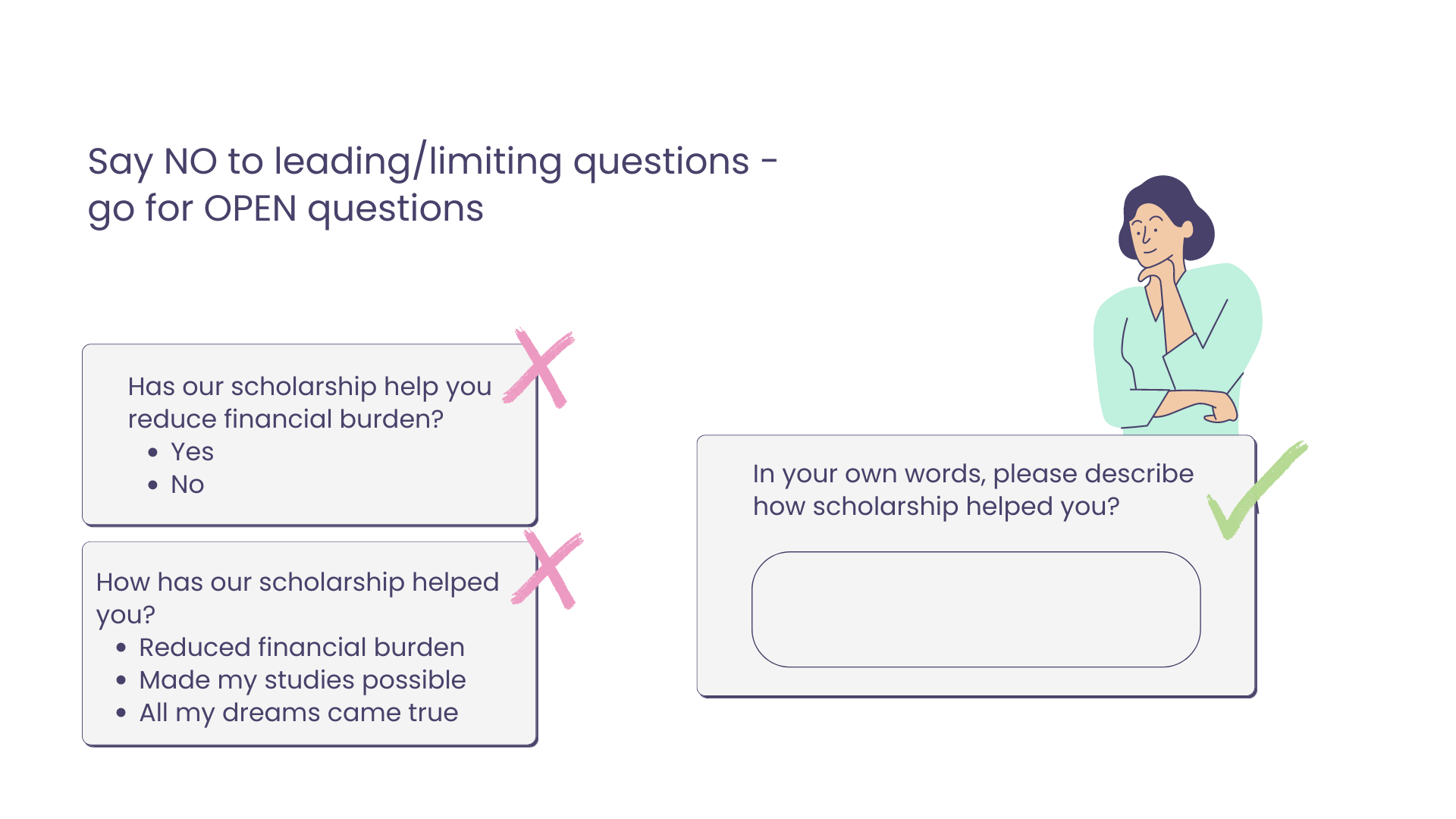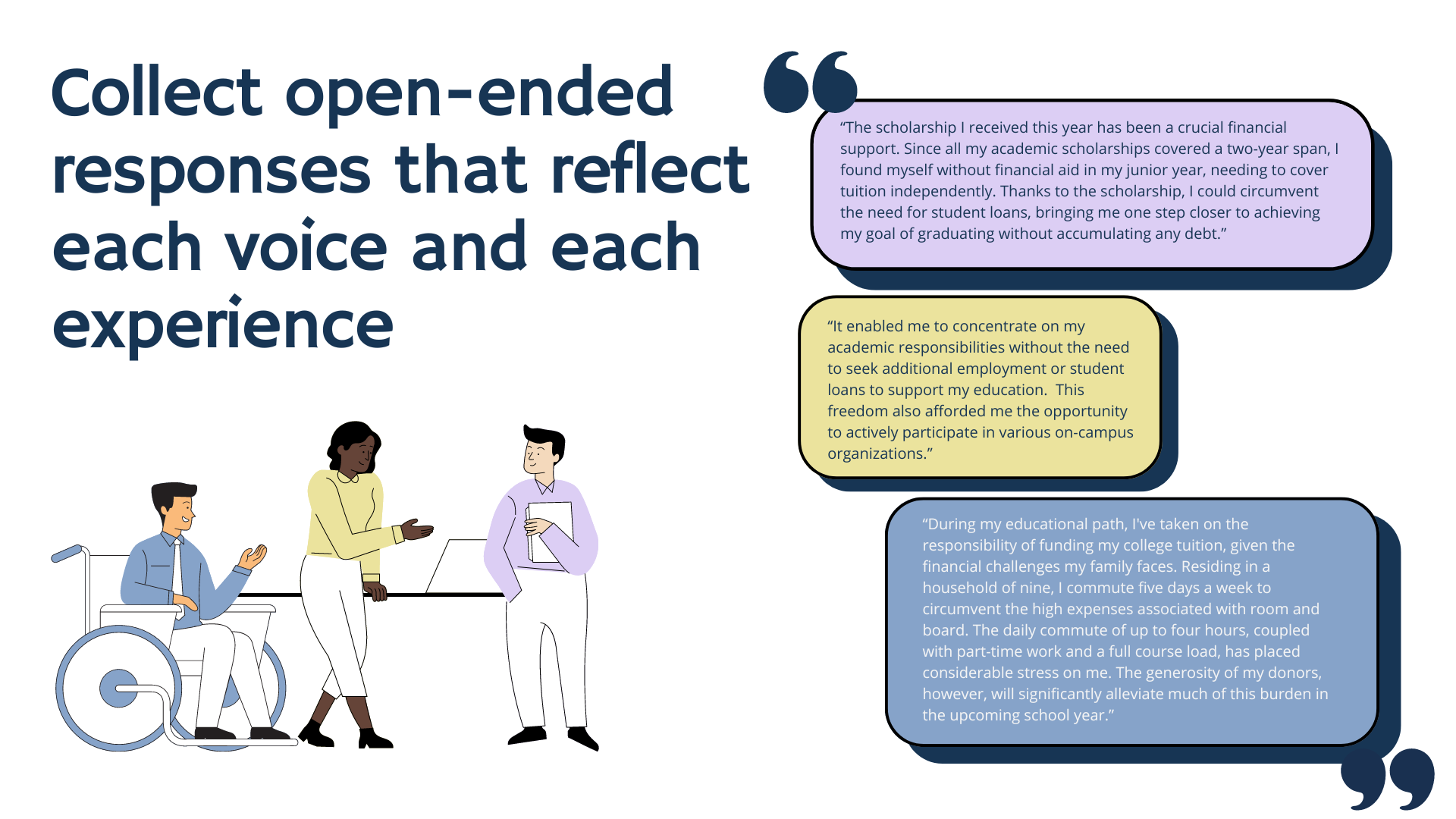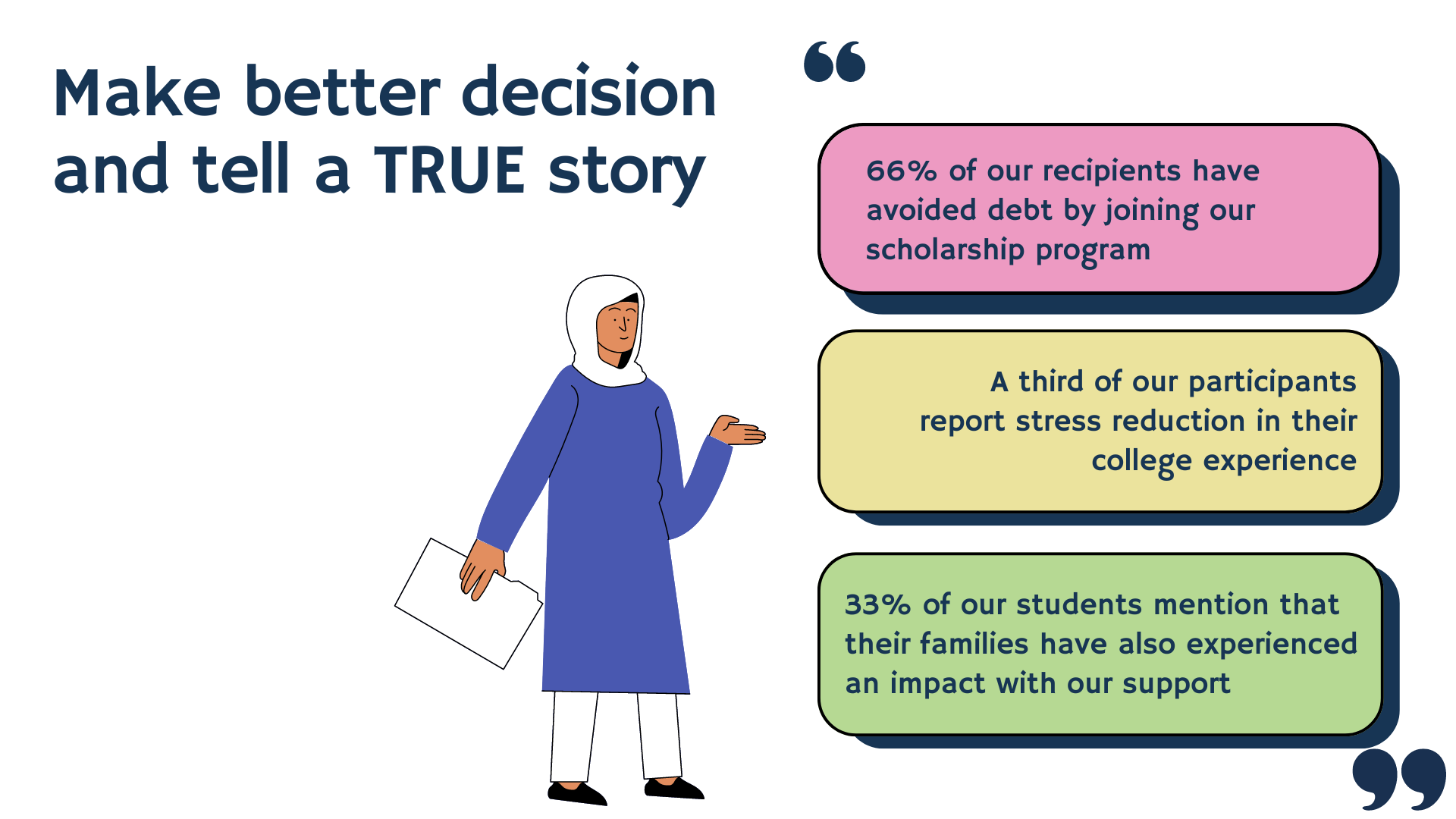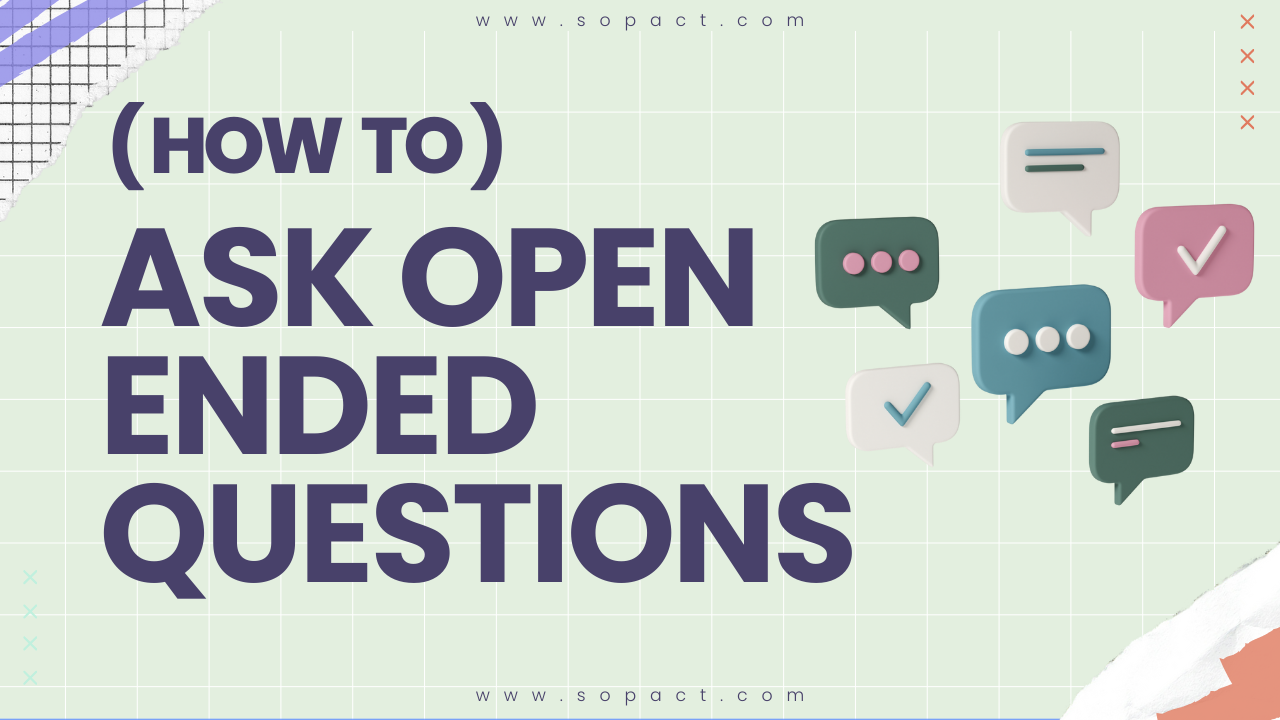Open-Ended vs. Closed-Ended Questions
In today’s rapidly evolving workforce development and education sectors, organizations must be equipped to gather and respond to real-time feedback. As AI-driven changes reshape the market, it’s critical to clearly communicate the value of your programs and their impact on stakeholders. However, many organizations face challenges in capturing and conveying the full scope of their success, often leading to a disconnect and missed opportunities for growth.
A key to overcoming this challenge lies in designing the right questions—questions that capture both the qualitative and quantitative dimensions of your work. Well-crafted surveys, featuring a blend of open-ended and closed-ended questions, are powerful tools in this process. Open-ended questions allow you to gather personal insights and experiences, while closed-ended questions enable you to measure program outcomes and effectiveness.
By designing surveys that generate both narrative and numerical data, organizations can:
- Capture genuine stakeholder voices: Understand the deeper needs and expectations of those engaged with your programs.
- Demonstrate clear program outcomes: Showcase measurable results that provide a comprehensive view of your program’s effectiveness.
- Strengthen stakeholder engagement: Build trust by presenting a compelling, data-driven story that motivates continued participation and support.
This article will guide you through the art of crafting effective questions, enabling you to design surveys that provide the insights needed to adapt and thrive in today’s fast-paced environment. With quicker feedback and meaningful data, you can demonstrate the success of your initiatives and secure the backing you need for continued progress.
Defining Open-Ended and Closed-Ended Questions
Open-ended questions allow respondents to provide unrestricted, qualitative responses in their own words. These questions typically begin with phrases like "how," "what," or "why," encouraging respondents to express their thoughts, feelings, and opinions freely. Examples of open-ended questions include "What factors influenced your decision?" or "How do you feel about this product?"
On the other hand, closed-ended questions offer respondents a set of predetermined response options to choose from. These questions often require a simple "yes" or "no" answer or ask respondents to select from a list of predefined options. Closed-ended questions are designed to elicit specific, quantitative responses and are often used to gather structured data efficiently. Examples of closed-ended questions include "Did you purchase this product?" or "Which of the following options best describes your experience?"
Advantages of Open-Ended Questions
One of the primary advantages of open-ended questions is their ability to capture rich, detailed responses. By allowing respondents to elaborate on their thoughts and experiences, open-ended questions provide researchers with a deeper understanding of complex issues. These responses can reveal unexpected insights, uncovering nuances that closed-ended questions may overlook.
Moreover, open-ended questions empower respondents to express themselves in their own words, fostering a sense of ownership and authenticity in their responses. This approach can lead to more honest and insightful feedback, as respondents feel valued and heard throughout the research process.
Additionally, open-ended questions are versatile and adaptable to various research contexts. They can be used to explore a wide range of topics and are particularly well-suited for exploratory research, hypothesis generation, and qualitative data analysis. Researchers can gain valuable insights into respondents' perspectives, attitudes, and behaviors, providing a holistic view of the subject under study.
Advantages of Closed-Ended Questions
Closed-ended questions offer several advantages, particularly in terms of data collection efficiency and analysis. By providing predefined response options, these questions enable researchers to gather standardized data quickly and easily. This structured approach streamlines the data collection process, allowing researchers to collect large volumes of data efficiently.
Moreover, closed-ended questions facilitate quantitative analysis, as the responses can be easily categorized and quantified. Researchers can use statistical techniques to analyze and interpret the data, identifying patterns, trends, and correlations with precision. This quantitative approach is particularly valuable for making data-driven decisions, evaluating hypotheses, and measuring the effectiveness of interventions or treatments.
Additionally, closed-ended questions minimize respondent burden by providing clear and concise response options. Respondents can answer these questions quickly, reducing survey fatigue and improving overall response rates. This efficiency is especially beneficial in large-scale research studies or surveys conducted in time-sensitive environments.
Open and Closed Ended Questions For Deep Insight
While both open-ended and closed-ended questions offer distinct advantages, choosing the right approach depends on the research objectives, context, and target audience. In many cases, a combination of both types of questions may be most effective, allowing researchers to gather comprehensive data while balancing the need for depth and efficiency.
For exploratory research or when seeking in-depth insights into complex phenomena, open-ended questions are invaluable. They encourage respondents to share their perspectives openly, uncovering nuanced details and diverse viewpoints. Researchers can use qualitative analysis techniques, such as thematic coding or content analysis, to identify patterns and themes within the data, enriching their understanding of the subject matter.
In contrast, closed-ended questions are well-suited for research scenarios that require standardized data collection and quantitative analysis. They enable researchers to measure attitudes, behaviors, and preferences systematically, facilitating comparisons across groups or time periods. Statistical analysis techniques, such as descriptive statistics or inferential tests, can be applied to closed-ended data to draw meaningful conclusions and make evidence-based recommendations.
Difference between open and closed ended questions
Open-ended and closed-ended questions are two fundamental types of questions used in surveys, interviews, and research studies. Each type has its own strengths and weaknesses, and the choice between them depends on the goals of the data collection process.
Open-Ended Questions in Surveys
Open-ended questions are a cornerstone of qualitative research, providing a window into the deeper thoughts, feelings, and motivations of respondents. They are particularly effective when you need nuanced insights or varied perspectives that structured data cannot capture. To craft effective open-ended questions:
Focus on the Specific: Tailor questions to gather specific information that aligns with the research objectives. For instance, instead of asking "What do you think about our product?" refine it to "What specific features do you like most about our product, and why?"

invite detailed and descriptive answers. Consider using phrases such as "describe in detail," "explain how," or "what led you to," which guide respondents to delve deeper into their experiences and reasoning. This approach not only enriches the data but also brings forth the nuances of personal narratives and insights.
Equally crucial is the formulation of questions that remain neutral, avoiding any language that might steer respondents toward a specific answer. This practice is fundamental to preserving the objectivity of the data collected, ensuring that the insights gained are a genuine reflection of the respondent's thoughts and not influenced by the wording of the question.
Moreover, a well-designed survey question should accommodate a spectrum of perspectives. By framing questions broadly enough, researchers can capture a diverse array of responses, thereby reflecting the varied experiences and opinions of all participants. This inclusivity enriches the data set and provides a more comprehensive understanding of the surveyed group.
In gathering open-ended responses, the goal is to create a platform where each voice and experience can articulate itself freely and distinctly. This approach not only respects the diversity of the respondent pool but also enhances the depth and breadth of the insights gained from the research.

Before launching a survey broadly, it’s crucial to test the open-ended questions with a smaller, representative group. This preliminary phase aims to ensure that the questions effectively elicit the type of responses anticipated. Observing how these respondents interact with the questions provides invaluable insights, allowing for adjustments and refinements to the survey based on actual feedback. This iterative process helps fine-tune the questions to better capture the depth and variety of data needed.
To streamline and enhance this process, employing a modern qualitative data analytics platform like Sopact Sense can be transformative. Sopact Sense dramatically reduces the time and effort traditionally required for data analysis, condensing months of work into mere minutes. With its advanced capabilities, it offers 30 times better accuracy, facilitating both inductive and deductive analysis approaches. Researchers can utilize bottom-up pattern analysis to identify emerging themes without prior assumptions, or apply top-down strategies to test specific hypotheses or code responses post-collection.
Furthermore, Sopact Sense enables detailed demographic filtering, empowering researchers to dissect data layers and uncover genuine causality and correlations. This capability is particularly valuable in understanding how different groups perceive and respond to various issues, enhancing the overall quality and applicability of the research outcomes. By integrating such advanced tools into the survey design and testing phase, researchers can achieve a more dynamic, responsive, and precise exploration of the data they collect.

To ensure that analytics efforts align closely with key organizational goals and foster actionable outcomes at an individual stakeholder level, it’s essential to craft a narrative that integrates both qualitative and quantitative data. This approach allows for a comprehensive understanding of how initiatives are impacting stakeholders, highlighting necessary adjustments and future strategies.
Creating a Comprehensive Narrative:
- Identify and Prioritize Goals: Start by clearly identifying the most crucial goals for the analytics project. Determine what success looks like for each goal and how it aligns with broader organizational objectives.
- Collect Qualitative and Quantitative Data: Use a mixed-methods approach to data collection. Qualitative data can be gathered through open-ended survey questions, interviews, and focus groups that explore stakeholders' feelings, experiences, and suggestions for improvement. Quantitative data should be collected through structured surveys, performance metrics, and other measurable indicators.
- Pre and Post Analysis: If applicable, conduct a pre-intervention analysis to establish a baseline, followed by a post-intervention analysis to measure changes. This comparative analysis can highlight the direct impacts of specific changes and help in communicating these changes effectively.
- Narrate the Story of Each Goal: For each key goal, create a narrative that weaves together the qualitative insights with the quantitative results. This story should outline what was initially found, what changes were implemented, and how these changes influenced the outcomes. Emphasize both the successes and the areas needing improvement.
- Detail Actionable Insights: Based on the narrative, extract actionable insights specific to each stakeholder group. Detail what steps will be taken to address the issues uncovered in the analysis. This might include strategic adjustments, resource reallocations, or new initiatives.
- Communicate Changes and Impact: Use the narratives to communicate with stakeholders about the changes made and their impacts. This communication should be clear and tailored to the audience, ensuring that each stakeholder understands how the findings relate to them and what future actions are planned.
- Plan for Continuous Improvement: Establish a plan for ongoing monitoring and evaluation based on the narrative outcomes. This plan should include regular check-ins and updates to the data collection and analysis processes to ensure they remain aligned with the organization's evolving needs and goals.
By meticulously linking each story to the most important analytics goals and utilizing a narrative that blends qualitative depth with quantitative rigor, organizations can not only achieve a more thorough understanding of their impact but also engage stakeholders in a meaningful way that promotes sustained improvement and strategic decision-making.

Closed-Ended Questions in Surveys
Creating closed-ended questions for surveys involves a meticulous design process to ensure that the quantitative data collected is accurate, clear, and meaningful. These types of questions are pivotal for confirming hypotheses, measuring trends, and obtaining data that are straightforward to analyze statistically. Here’s how to enhance the effectiveness of closed-ended questions in your surveys:
1. Define Clear Options
To begin, it’s crucial that each closed-ended question provides specific, mutually exclusive categories. This step is essential to cover all possible responses, thus eliminating any potential ambiguity or overlap. For example, if you're asking about frequency of service usage, your options should range clearly from 'Never' to 'Daily' without any vague terms in between. This clarity ensures that the data you collect can be analyzed straightforwardly, leading to more reliable insights.
2. Balance the Scales
Using balanced rating scales, such as Likert scales, can significantly enhance the quality of the data gathered. These scales should offer an equal number of options on either side of a neutral option (if one is included) to ensure an unbiased distribution of responses. For instance, a satisfaction survey might use a scale from 'Very Dissatisfied' to 'Very Satisfied' with 'Neither Satisfied nor Dissatisfied' as a midpoint. This balance helps in minimizing response biases, providing a more accurate picture of respondent sentiments.
3. Keep It Simple
Each question should be formulated to be as clear and straightforward as possible. The language used needs to be simple enough that respondents do not require additional information or context to give an answer. This approach reduces the risk of misinterpretation and ensures that responses are based on the respondents’ true opinions and experiences. An example might be using "Do you agree that the customer service was helpful?" instead of a more complex phrasing that could confuse the respondent.
4. Include an 'Other' Option
Sometimes, even well-designed questions might not capture all possible respondent experiences. In such cases, including an 'Other' option with a space for respondents to specify their answer can be invaluable. This option acts as a safety net, capturing data that might otherwise be missed and offering insights that could lead to new discoveries or considerations in your analysis.
5. Pre-test Your Questions
Before deploying the survey to a larger audience, conduct a pre-test with a small, representative group. This testing helps ensure that the questions are understood as intended and that all potential responses are adequately covered. Gather feedback on the clarity of the questions and the adequacy of the response options. Use this feedback to make necessary adjustments, refining your survey to better meet its objectives.
Putting It All Together
When these elements are carefully integrated into the design of closed-ended questions, the resulting data becomes a powerful tool for statistical analysis and decision-making. These questions not only streamline the data collection process but also enhance the precision and applicability of the insights gained. By rigorously crafting and testing your closed-ended questions, you ensure that the survey effectively measures the intended variables and yields high-quality data that can support robust conclusions and strategic actions.
Open and Closed-Ended Questions in Survey Design
Incorporating both open and closed-ended questions in surveys can significantly enhance the data collection process by melding the depth of qualitative feedback with the quantitative data's scope. This dual approach proves invaluable in multifaceted research areas, where understanding the underlying reasons behind behaviors, decisions, or preferences is key.
Sequential Integration: Begin with closed-ended questions to collect broad data, then follow up with open-ended questions to delve into specific areas of interest more deeply. This technique helps provide a contextual backdrop for the quantitative findings through rich qualitative insights.
Parallel Integration: Simultaneously employ open and closed-ended questions regarding the same subject within a survey. This strategy captures a wide array of data, offering both statistical comprehensiveness and insightful qualitative depth.
Iterative Design: Utilize initial survey responses to refine or introduce new questions that probe deeper into significant themes that arise. This responsive design allows the survey to evolve based on real-time insights, making it highly adaptive to the research needs.
By strategically combining these approaches, researchers can leverage the strengths of both qualitative and quantitative methodologies, resulting in more rounded and actionable data.
For more detailed strategies on mixed-method surveys, refer to the guide provided by Sopact. Learn more about mixed-method surveys at Sopact.

Conclusion
In conclusion, the choice between open-ended and closed-ended questions is a critical consideration in research design and data collection. Each type of question offers unique advantages and limitations, influencing the depth, efficiency, and quality of insights obtained. By understanding the strengths and weaknesses of both approaches and selecting the most appropriate method for each research context, researchers can maximize the value of their findings and generate meaningful contributions to their field.


